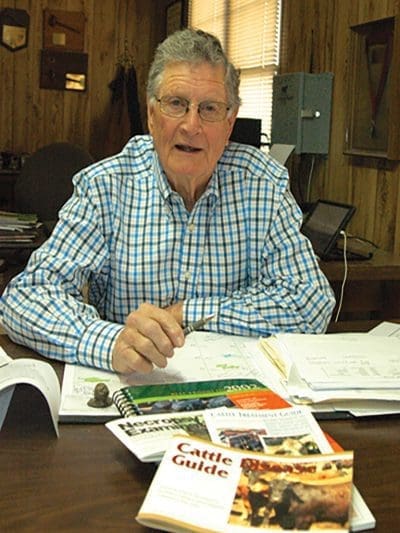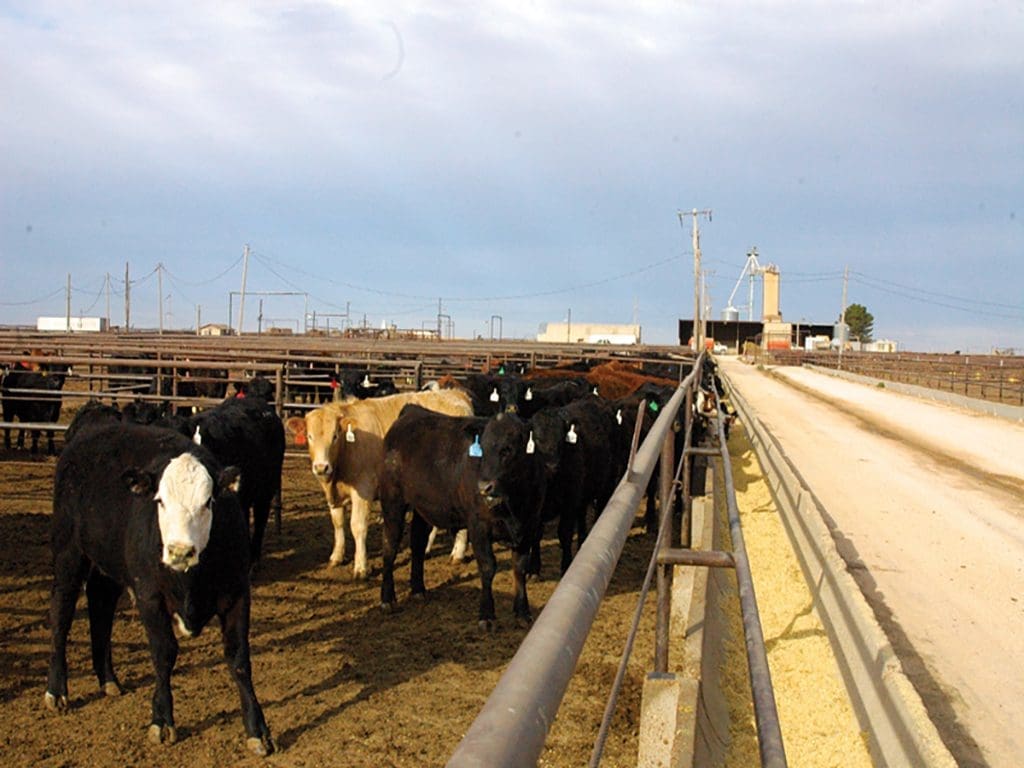Home of Feedyard
Pharmaceuticals Research
By Larry Stalcup, Contributing Editor
There are ways to prevent bovine respiratory disease (BRD) in cattle, but there’s not a “miracle-mycin” that magically keeps BRD from hurting a herd and keeping chronics out of the feedyard.
David Bechtol, DVM, founder and owner of Palo Duro Consultation, Research and Feedlot, and Agri Research Center, Inc., outside Canyon, Texas, lives by those words in describing results of his four decades of testing cattle vaccines, antibiotics, wormers and other animal health products. His 3,500-head research feedyard remains a key resource for pharmaceutical companies and others who hope to make new or improved products available to cow-calf producers, stocker operators and cattle feeders.here are ways to prevent bovine respiratory disease (BRD) in cattle, but there’s not a “miracle-mycin” that magically keeps BRD from hurting a herd and keeping chronics out of the feedyard.
Bechtol was raised in Amarillo and served in the U.S. Marine Corps in the 1950s. He later attended Texas Tech University, West Texas State University (now West Texas A&M) and graduated from the College of Veterinary Medicine at Texas A&M University. He has worked with virtually all bovine pharmaceutical companies since large-scale cattle feeding exploded in the Texas Panhandle and High Plains in the 1960s.
From 1966 to 1974 he had a private veterinary practice in Dimmitt. He also began specializing in feedyard herd health consultation.
“Pharmaceutical companies came to us to do research in commercial feedlots,” Bechtol remembers. “It was hard to do that efficiently. So we built this facility in 1979. I continued my consulting practice and, at one time, had seven people on the staff. As the company grew, I started doing more research and less consulting.”
Along with BRD, the Agri Research Center has studied ways to treat and control BVD, internal and external parasites, liver flukes and other diseases. It was also part of early research to develop implants, ionophores and other products designed to promote better performance and more efficient cost of gain. “Our first trial was on the Synovex® implant,” Bechtol notes.
However, BRD has had most of the research yard’s attention. Bechtol and yard manager Audie Waite have worked together since nearly day one. “We’ve done over 600 studies at this facility. We developed a respiratory disease model where we could assimilate how the disease complex impacts a herd or pen of cattle,” Bechtol says. “We worked on prevention through vaccines, along with control with antibiotic-type products. We’ve done some kind of work on just about every product approved in the U.S. for respiratory disease.”
He follows protocols designed for the use of animal health products. The research yard also takes extra steps to help confirm research techniques and findings. “Nearly all of our research is confidential,” Bechtol says. “We have standard operating procedures set up to show how we handle cattle when they come in, how they’re fed, records we keep and other data. Some individualized protocols require us to write up a standard operating procedure to meet their needs.”
Antibiotics resistance is a hot topic these days, but it’s nothing new to Bechtol. “I’m a little old school. One of the first seminars I attended after graduating veterinary school was on drug resistance,” he says. “The consuming public needs to understand that we are very concerned about [food] safety and good, wholesome beef. It also involves economics.
“We don’t use a bunch of drugs because we can. We want to make sure the product works. With our Veterinary Feed Directive, we show how we use a product in the feed in the exact way it is approved. That to me is showing we’re on top of everything.”
Bechtol notes that his research puts him on the other side of the fence. “I’m producing a model to make cattle sick. It goes against the grain,” he says. “But I do it to evaluate an antibiotic or vaccine. I know how to prevent BRD. Large commercial feedyards and cowherds normally follow a good prevention program. But with our small-herd situation across the nation, we still have a hard time getting everyone to maintain a prevention program in their herds.”
He compares a ranch sending calves to market to a child from a sickness-free home going to kindergarten the first time. “The child doesn’t get sick at home, but is exposed to 100 kids at schools. There are snotty noses, coughs and other illnesses to contend with. The child gets sick. It’s the same thing with cattle. There may be little sickness at the calm ranch herd. But when they hit the sale barn or feedyard, they can be exposed to all kinds of diseases.
“If they haven’t been part of a preconditioning and vaccination program, they can face major problems. Also, many herds will see some cattle that don’t respond to a good animal health and preconditioning program. We know how to prevent BRD. We have the tools in vaccines and antibiotics, but still don’t always get 100-percent efficacy.”
Early research helped develop what is now Micro Beef Technologies’ electronic cattle management system and chute-side health programs. Micro Beef founder Bill Pratt spent a lot of time at the research feedyard. Bechtol has also developed many educational materials designed to help cattle feeding be more efficient.
“That began in the late ‘80s,” he says. “We had a large notebook and revised it several times. We also developed pamphlets to help feedyard cowboys. Those materials were also put on CDs and a thumb drive. I think we’ve helped train a lot of feedyard cowboys.”
A system that uses GrowSafe feeders and data collection helps the facility identify exact feed intake and gain. Agri Research Center also does small custom feeding programs for regional ranchers and seedstock operators.
“For our normal research, we receive cattle from across the Southeast and Southwest,” Bechtol says. “But we also have pens devoted to custom feeding. We have different size pen spacing to handle from 10 head to 250. That enables seedstock operators to evaluate small or large numbers of cattle produced from their genetics.”
Bechtol doesn’t mind admitting that he’s been associated with the regional feeding industry for a long time. “I was at the XIT in Dalhart when they dug the first post hole,” he quips. “And as far as feedyard companies go, I’ve been hired and fired by several of them. We still do a lot of research on new products that companies are trying to bring on the market. You just hope you are doing something to help the industry.
“But everyone has to realize there is no ‘miracle-mycin’ out there.”







